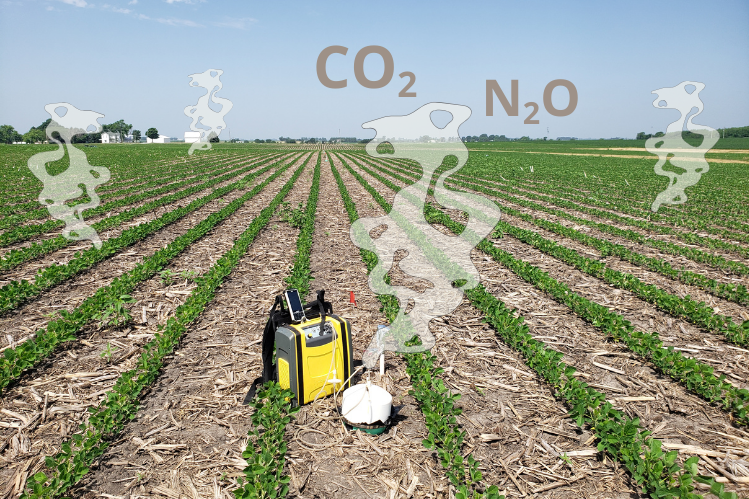Illinois leads most rigorous agricultural greenhouse gas emissions study to date

Farmers apply nitrogen fertilizers to crops to boost yields, feeding more people and livestock. But when there’s more fertilizer than the crop can take up, some of the excess can be converted into gaseous forms, including nitrous oxide, a greenhouse gas that traps nearly 300 times as much heat in the atmosphere as carbon dioxide. About 70% of human-caused nitrous oxide comes from agricultural soils, so it’s vital to find ways to curb those emissions.
Before they can recommend practices to reduce nitrous oxide and other greenhouse gases from agricultural soils, scientists first have to understand where and when they are released. Sampling soil emissions is labor intensive and expensive, so most studies haven’t done extensive sampling over space and time. A new study from the University of Illinois Urbana-Champaign sought to change that, rigorously sampling nitrous oxide and carbon dioxide emissions from commercial corn and soybean fields under practical management scenarios over multiple years. Not only can this dataset lead to mitigation recommendations, it can refine the climate models that predict our global future.
“Mitigating agricultural soil greenhouse gas emissions can help us meet global climate goals,” said study co-author Chunhwa Jang, research scientist in the Department of Crop Sciences, part of the College of Agricultural, Consumer and Environmental Sciences at Illinois. “High spatial and temporal resolution, large-scale, and multi-year data are necessary to establish well-informed mitigation strategies. Before our study, these datasets just didn’t exist.”
Jang and colleagues under Kaiyu Guan’s leadership from the Agroecosystem Sustainability Center leveraged funding from the U.S. Department of Energy’s ARPA-E SMARTFARM program to create the most extensive dataset yet available for on-farm nitrous oxide and carbon dioxide emissions. They laid out a large network of gas sampling sites in commercial corn and soybean fields under conventional, conservation, and no-tillage management.
Imagine a field fitted with tiny ground-level smokestacks pumping out gases from the soil. The researchers would visit with machines to measure the concentration of those gases weekly or biweekly throughout the season for two years. Smokestacks that consistently pumped out high concentrations of gases were termed hot spots. Hot moments were when concentrations rose across most or all of the smokestacks after events like rainfall or fertilizer applications.
“We found carbon dioxide flux was similar across individual fields, sites, and years, or even between corn and soybean systems,” Jang said. “These results tell us that carbon dioxide emissions are consistent and that high spatial resolution sampling is likely sufficient to estimate field-wide flux.”
Nitrous oxide, on the other hand, was anything but consistent. Not only did the amount of nitrous oxide at a particular smokestack swing dramatically from one sampling session to the next (hot moments), the researchers found that they couldn’t predict where in the field they’d find hot spots on any given date.
“Spatially and temporally, nitrous oxide was very variable,” Jang said. “One day, point A would be having a hot moment, and then at the next measurement, we’d find hot moments at points B and C. The hot spots were just moving around.”
This finding is important because if previous studies only sampled at a couple of spots or on a couple of dates, their estimates for nitrous oxide flux could be wildly off. These measurements inform the global climate models that tell us how soon we will reach critical tipping points, so it’s immensely important that they’re as accurate as possible.
“This project enabled us to capture spatio-temporal and management variation to provide gold standard data and a platform for validating field-level greenhouse gas emissions,” said study co-author DoKyoung Lee, professor in crop sciences at Illinois. “This is necessary for sustainable practices to secure both food and bioenergy demand and minimize emissions to the atmosphere.”
The results also revealed how management and cropping systems influence greenhouse gas emissions. Carbon dioxide emissions were similar for corn and soybean and for conservation and no-tillage, but conventional chisel tillage and continuous corn saw higher concentrations. Nitrous oxide, on the other hand, was far higher in corn than soybeans under conservation and no-tillage, and nearly off the charts in continuous corn under chisel tillage.
“We may not be able to predict where and when nitrous oxide will spike, but we do know management makes a difference,” Jang said. “In continuous corn, farmers have to apply high amounts of nitrogen fertilizer, which converts into nitrous oxide. And conventional tillage interrupts the soil surface and releases gas. We know what to do to mitigate it.”
The study, “Spatial variability of agricultural soil carbon dioxide and nitrous oxide fluxes: Characterization and recommendations from spatially high-resolution, multi-year dataset,” is published in Agriculture, Ecosystems, and Environment [DOI: 10.1016/j.agee.2025.109636]. Authors include Nakian Kim, Chunhwa Jang, Wendy Yang, Kaiyu Guan, Evan DeLucia, and DoKyoung Lee.
Lee is also affiliated with the Institute for Sustainability, Energy, and Environment, the Agroecosystem Sustainability Center, the Center for Advanced Bioenergy and Bioproducts Innovation, the Center for Digital Agriculture, and the National Center for Supercomputing Applications at U. of I.